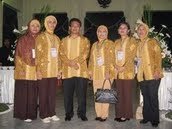Current Issue and Trends in Nursing Soul
By Iyus Yosep
Current trend or issue in a spirit of nursing problems that were discussed and considered warm essential. These problems can be considered a threat or a challenge that will have a major impact on the soul of nursing in both regional and global order. There are several important trends of concern among people in nursing are:
• Mental health began during the conception
• The trend increase in mental health problems
• Trends in the etiology of mental disorders
• Trends situation in the global era
• Globalization and changes in health orientation
• The tendency of mental illness
Increased post traumatic syndrome
Increased psychosocial problems
Trend suicide in children
AIDS and drug problem
Pattern of Parenting
Presfektif life span history
Violence
economic problems and poverty
1. Mental health began during the conception
Concluded that recent developments speaking mental health problems must begin from the time of conception. Instead, should start from the prenuptial. Many studies indicate a connection in the womb with the mental and physical health of a person who will dimsa dating. The following studies show that one's mental health began during conception
Van De Carr (1979) found that a great musician who was born of a father who cultivate music, patterns have been studied in the womb when unborn babies are exposed to familiar voices regular song composition.
Another group are those who come from families who suffer from schizophrenia, and many suffer from some mild symptoms psychiatry. Until now the genetic factors believedto have a major role in the etiology of disease.
2.Trend of Increasing Mental Health Problems
Mental problems will increase in the era of globalization. For example the number of mentally ill patients in other provinces of Yogyakarta Special Region continues to increase. Patients are no longer dominated by lower-class society. Among officials and the public upper middle layer, also touched psychotic and depressive disorders.
The trend is visible from the number of patients who undergo inpatient or outpatient hospital Grhasia Yogyakarta and Sardjito Hospital Yogyakarta. At the hospital's mental clients continue to grow since the year 2002. In 2003 alone the number reached 7,000 people, was in 2004 rose to 10,610 people. Some of the clients undergoing outpatient, and clients who undergo inpatient reached 678 people in 2003 and increased to 1314 people in 2004. Interestingly, psychotic clients now no longer dominated by the lower classes, but among the students, civil servants, private employees, and professional circles as well in between. Clients of mental disorders upper middle class, largely due to not able to manage stress and there are also cases of people who have experienced post power syndrome due to mutations fired or office.
3. The Trend in The Etiology of Mental Disorders
Occurrence of war, conflict, and a prolonged economic crisis winding is one of the triggers that led to stress, depression, and various mental health disorders in humans. At least not according to WHO, there is one of four people in the world have mental problems.
4. Tendency Situation in The Global Era
The development of science and technology is so fast and free trade is the cirri of the era of globalization. Nurse soul as the soul of nursing care to clients is part of the total service in the hospital. Therefore they are required to be able to provide professional nursing care and could account for upbringing gives scientific yng
5. Globalization and Changes in Health Orientation
Indicator future mental health is no longer a problem as the prevalence of clinical mental disorders, but oriented to the context of social life. Therefore, efforts to ensure the mental health matters is no longer just a psychiatrist, but also involves
other professions
6. The Tendency of Disease
Increased post traumatic syndrome
When the tsunami in Aceh, many people are exposed to traumatic events, the experience, watching the events in the form of threats of death or real death and injury as well as their deep threat to the physical integrity of self or others. Response occurs in the form of a strong fear and helplessness, while for the children what the deal will be expressed with the chaotic behavior
Increased psychosocial problems
For example:
psychotic homeless
people with mental disorders
The problem of street children
Problems teenager
sexual problems (sexual, deviations, sexual harassment), and so on.
Trend suicide in children
Suicide is the psychological problem that is threatening the world. Since 1958, over 100,000 Japanese people 25 people dead by suicide. As for the State of Austria, Danish and English, on average 23 people. The first sequence number occupied by Germany with 37 people per 100,000 population. Now the worrying trend of suicides began to appear increases occurred in children and adolescents.
AIDS and drug problem
Pattern of Parenting
Given the large number of suicide and depression in children, the current parenting families back into the spotlight. Good parenting is parenting in which parents apply high heat coupled with high control.
Perspective life span history
Violence
Economic problems and poverty
Economic problems are the most dominant issue initiated a mental disorder in Indonesia. This can be proved that when there is an increase in fuel is always accompanied by an increase in double digits a mental disorder.
Trends and The Issue of Mental Nursing Service Development in The Globalization Era
By Suryani
I. Introduction
Globalization era is an era where there is no longer a barrier between the countries, especially in the field of information, economy and politics. The development of science and technology are so fast and free trade which is cirri this era, have an impact on the health sector in particular. Current health care providers (care providers), including mental health should be able to compete, because consumers will choose providers a higher quality of service that they are biased to ensure healing. Nurse soul as the soul of nursing care to clients is part of the total service in the hospital. Therefore they are also required to mamapu provide professional nursing care that can account for upbringing that gave scientifically. Along with the development of nursing ilmupengetahuan and teknologidibidang which in this case is science and technology in nursing soul. For this field of research in nursing should be developed primarily soul soul clinical research.
Era of globalization or free trade or not have been aware of impact on health services. The two main things that affect the development of health services including nursing, namely the availability of alternative service and competitive organization of services to attract users services. In fact competition is competition quality. This means that health workers including nursing staff must have a global standard in providing health services, or they do not want to miss. (Suhaemi, 1997)
II. The tendency of disease
According to the ICN (1997), quoted by Suhaemi (1997) that 2020 years later the world will shift the disease. Infectious diseases will be controlled, AIDS will continue to be a major problem. Mental health problems will become "the global burdon of disease" (Michard & Chaterina, 1999). This will be a challenge for the "Public Health Policy" which traditionally members pay more attention on infectious diseases. Standard measurements for global health needs of traditionally is the number of deaths from the disease. This has caused mental disorders as if not a problem.
1. Increased Post Traumatic Syndrome Disorder
2. Psychosocial Problems Increasing
3. Trend of suicide in children and adolescents
4. Drug problems and HIV / AIDS
5. Pattern of parenting in nursing soul
6. Economic problems and poverty
III. Trends in psychiatric mental nursing service
a.Brief history
Psychiatric mental nursing as a profession emerged in the early 19th century. Nursing interventions in the early days is still focused on the disease model rather than looking at the client intact. Then, since the year 1940 mental psychiatric nursing began to develop rapidly, but the service is still concentrated in the hospital (Antai Otong, 1994). It was not until around the 1960s, the psychiatric nurse's role in the community began to grow. This happens in line with deinstitutionalization program.
Deinstitutionalization is a client acquisition program with chronic mental hospitals and institutions and return them to the environmental rehabilitation in the community (Lefley, 1996). This program was launched because it proves that client-centered treatment in hospital is not effective. Preventive primary, secondary, and tertiary the bias is only done if the patient is returned to the community environment. Found the incidence of early cases, early diagnosis, and crisis intervention (Gerald Kaplan cited by Antai Otong, 1994)
Until now deinstitutionalization program continues in some countries especially in European countries and the United States. With the development of this program, the community lot of mental health services. Examples in Melbourne, Australia, there are several mental health programs are like Crisis Assessment and Treatment Service and Community Mental Health Center (H & CS, 1996). Even today there Psychosocial Early Prevention and Intervention Center provides specialized services in cases of early psychosis (Lambert, M, 2001)
b.Trend mental psychiatric nursing service in an era of globalization
Leinenger (1973) suggests that changes in hospital-based care to community-based care is the most significant trends in the treatment of mental disorders. Leinenger (1973) suggested 3 main key in this process:
• Experience and nurse education
• The role and functions of nurses, as well as
• Relationships with other professional nurses in the community
c. Around Issue Psychiatric mental nursing service
Mental psychiatric nursing services are less biased in a scientifically accountable for this because it is still a lack of research results in nursing.
Psychiatric nurses are poorly prepared to face the free market because of low education and lack of a license to practice internationally recognized bias.
Contrasting the role of nurses based on education and life experience is often not clear in "position description, job responsibility and reward system within the nursing service where they work (Stuart Sundeen, 1998)
Being a psychiatric nurse is not an option for students (nursing students), they tend to avoid the profession.
V.How mental psychiatric nursing profession in Indonesia to deal with?
In the face of trends and evolving issue, mental nursing psychiatric profession in Indonesia has taken measures such as making the standard of nursing practice in the mental hospital, a nursing professional practice model (MPKP) in a psychiatric hospital, and conducted various training such as nursing care of the soul and training "clinical instructor" for mental psychiatric nurse. However, perhaps there is still much needs to be addressed and improved in order to be able to face all challenges in the future.
Here are some things that should concern mental psychiatric nursing profession in the face of trends and the issue of mental psychiatric nursing service in the era of globalization.
1. In connection with the trend of major health problems and mental health services globally, it focuses people's nursing service time based on the community (community-based care) which gives emphasis on preventive and promotive.
2. In connection with the improvement of science and technology is very fast, need improvement in science by developing educational institutions that already exist and a spirit of nursing specialty programs. Equally important is to increase research on mental nursing mental nursing psychiatric clinic primarily.
3. In order to maintain the quality of services provided and to protect consumers, it's time there is a "license" for nurses who work in the ministry.
Due to differences in our cultural backgrounds, the keynote speaker, which in this case we still refer to the western countries especially the United States, it is necessary to refine the concepts of psychiatric mental nursing obtained from outside. Estin (1999) stressed that to build trust and therapeutic relationships with clients and to prevent delays in diagnosing client needs, nurses need to understand the culture, values, beliefs, and attitudes toward illness clients.
Mental disorders in the 21st Century
By Sheila L. Videbeck
Department of Health and Human Services (1999) estimates that 51 million Americans can be diagnosed with a mental disorder. Of these, 6.5 million suffered disability due to a severe mental disorder, and 4 million are children and adolescents. For example, 3% to 5% of school age children experience hyperactivity disorder / attention deficit. More than 10 million children younger than seven years of growing up in homes where one parent suffering from significant mental or substance abuse that hamper their readiness to enter school.
Some experts argue that deinstitutionalization have positive and negative effects (Torrey, 1997). Although the number of beds in public hospitals decreased by 80%, there is an increasing number of patients in the hospital for 90% (Appleby and Desai, 1993). This led to the term "revolving door effect". Patients with persistent mental disorders and weight treated in a short time, but their frequency in higher hospital. Psychiatric unit of a general hospital overwhelmed with patients with continuous flow in and out of the hospital quickly. The number of visits of individuals who experience an acute disruption to emergency rooms increased 400% to 500% in some cities.
Many experts argue that the current patients more aggressively. Four to eight percent of patients in psychiatric emergency room carrying a weapon (Ries, 1997), and about 1,000 murders a year committed by people with persistent mental disorders and weight that are not getting adequate treatment (Torrey, 1997). Ten to fifteen percent of prisoners in government prisons suffer from mental disorder persistent and severe (Lamb & Weinberger, 1998).
Trend and Issue Dimensions in Nursing Care Plan Spritual Soul
The speed of information and human mobility in the era of modernization currently so high that there social and cultural relations. Social relationships between people perceived decreased end - the end of this, sometimes even limited to just imitation. Though the Indonesian people who have / upholds traditional oriental very concerned about these social relationships. Thus we should be wary of such loss of identity. Changes that occurred earlier can make sense of confusion because it appears uncertain sense of morals, norms, values - values and ethics and even laws. According to Dadang Hawari (1996) case - it can cause psychosocial changes, among others: the pattern of social life becomes materialistic religious and secular. Traditional religious values and modern diera be permissive, and so on.
Changes - changes that can be felt not only affect the physical but also mental, as was the standard WHO (1984) which is said not only physical health but also mental, social and spiritual. Health standards submitted by the WHO can be a great opportunity for nurses to do much, because nurses have the opportunity for contact with clients 24 hours a day. It was in this paper we intend mebahas about the spiritual dimension, the spiritual dimension in health, the concept of providing spiritual nursing care and nursing process in the spiritual dimension.
Understanding Spiritual Dimension
Spritual according to the New Webster's Dictionary (1981, pp. 1467): the spirit comes from the Latin of spirare. Spirare means hembus or breath. This spirit is the very principle of human life. He is in the human body, the soul, and separated from the human body die. This is in accordance with the spirit of understanding in Indonesian dictionary (Dep Brother Bud 1990), which means spirit, soul or spirit spiritual meaning while psychiatric, spiritual, mental or moral.
Spritual by Taylor, 1997 is anything that humans use to deal with something that is not material that gives the power of life and greater strength. Spiritual described as a part of something that came to be known, loved, and service to God, in other words the relationship without limit, and experience that has an overall strength.
According to Fish and Shelly, 1978 (from Taylor, et al, 1997) in charge of the spiritual needs of all religious traditions and are common to everyone, including the need for meaning and purpose, love and relate to each other, forgive each other.
Of all the terms of the spiritual above the needs of every individual, that individual will be satisfied if spritualnya needs are met. Conversely, if not met, the individual is not met her needs as a whole.
Spiritual dimension in health
In the practice of science and religion are not dichotomous but rather between the two have integrated (mutual support). As said by Albert Einstein, inventor of the atomic scientists, science without religion is like a blind man, but religion without science is like the lame.
Referring to the importance of knowledge and religion to mental health conducted numerous studies of a study that said the group was disturbed not to have a good religion and vice versa. Karl Jung had concluded from his analysis that those who suffer from mental illness experiencing a spiritual emptiness. Therapy lies in a strong spray of faith.
Recent Issues Affecting Psychiatric Mental Health Nursing
The 1990s were called the decade of the brain by the National Institute of mental health due to the multitude of scientific advances growing out of brain research. Numerous imaging techniques expanded our understanding of the neuro physiology and neuroanatomy of the brain. Neurobiologcal changes were observed in people with mental disorder, which led to a stronger emphasis on psychopharmacological treatment. Many of the most serious psychiatric disorder are now categorized as diseases of the brain.
In 1994, the ANA published the Psychiatric Mental Health Nursing Psychopharmacology project, which recommended that nursing programs prepare nurses with a solid foundation neuroscience and psychopharmacology as these relate to mental illness (ANA, 1994).
Furthermore, results of the human genome project started to support biological and genetic explanation for psychiatric condition (Cohen, 2000). Research has begun to valid the effectiveness of same complementary therapies, leading nurses to include these in comprehensive care (Ahmed & Maurana, 1999). The information explosion from daily access to the internet has provided nurse with a constant stream of new findings relevant to nursing care. The challenge for the psychiatric mental health nurse is how to absorb all of this new knowledge & skins and get not lose sight of the core values of psychiatric nursing . for example, the meaning of the nurse-client relationship (Forchuk et al, 2000)
Refferences
Yosep, Iyus. 2009. Keperawatan Jiwa. Edisi Revisi. Bandung: Refika Aditama
Suryani.2005.Trend Issue Keperawatan Jiwa di Era Global.majalah keperawatan unpad vol.4 : 75-78
Videbeck, Sheila L. 2008. Psychiatric Mental Health Nursing. Edisi bahasa Indonesia. Jakarta : EGC
Varcarolis,Elizabeth M,et.al.2006. Foundation Of Psychiatric Mental Health Nursing. USA : Elsevier Inc
http://akperkaltara.ac.id/index.php?option=com_content&view=article&id=116:isu&catid=3:askep&Itemid=18 [acessed december,20,2009. 4.40 pm]
skip to main |
skip to sidebar

Mr. Iyus Yosep,S.Kp.,M.Si.


logo

me n mental disorder patient (1)

me n mental disorder patient (2)

me n mental disorder patient (3)
Trend and Current Issues in Indonesian Mental Health Nursing.Sumarni
clock
calendar
My Profil
our Lecturer

Mr. Iyus Yosep,S.Kp.,M.Si.
Mental Health Nursing Team
Nursing Faculty

logo
Blog Archive
Friends Web Link
- anita_fauzia
- anita_putri_wijayanti
- arti_primiarti
- astrida_veronica
- dariah_parwulan
- dewi_aprianti
- dhika_darmansyah
- dila_agustine_i p
- ellys_lestari_mustofa
- erida_simamora
- fitri_rahmawati
- gurdi_R_sidabutar
- indri_dwi_rakhmi
- indri_ramadini
- intan_septina
- nanny_sutra_s
- neri_rahayu_lestari
- nicka_kurniah
- nur_eni_lestari
- reni_suherni_thanamar
- rina_wanti
- riri_asneli
- rismaya_juariah
- sartika_sri_rahayu
- seftiani_widiasari
- septina_priyanti
- siti_nurjanah
- tati_yulianti
- tegar_perdana
- tri_handayani
- ulfa_khoyrunnisa
- vivin_afriza
- yeni_liana
- zustantria
my photo

me n mental disorder patient (1)
my photo

me n mental disorder patient (2)
my photo

me n mental disorder patient (3)
Trend and Current Issues in Indonesian Mental Health Nursing.Sumarni| by Icons Supported by Design by Lecca ,Modern Home, Blogger Layout|. Powered by Blogger| Subir







